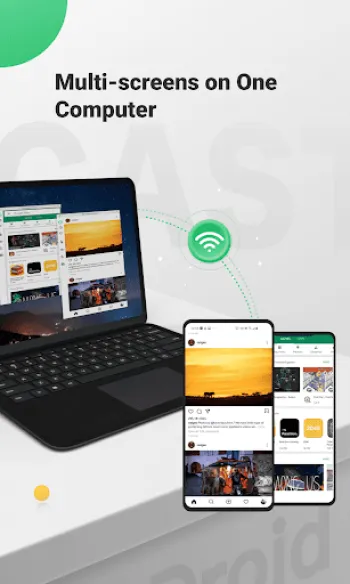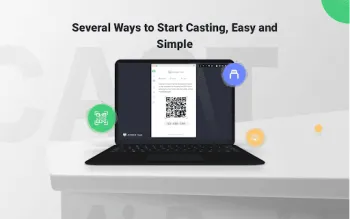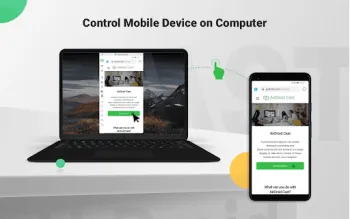Apps Zone

AirDroid Cast-screen mirroring
Comprehensive Exploration of Open Air Streaming Architecture and Control Mechanisms
The technological landscape of open air streaming has witnessed a paradigm shift propelled by advancements in wireless communications, streaming protocols, and device interoperability, culminating in systems that afford full control over real-time content dissemination across diverse platforms. The essence of ultimate open air streaming lies in its ability to transmit live audiovisual data seamlessly to myriad devices without physical barriers while preserving high fidelity, minimal latency, and user interactivity. Architecturally, this involves robust encoding and compression algorithms such as H.264/AVC or H.265/HEVC, combined with adaptive bitrate streaming approaches that dynamically adjust video quality based on network conditions to optimize user experience. The streaming pipeline commences with app-driven ingestion of mobile device screens, where GPU-accelerated screen capture concurrently encodes video and audio streams. On the transport layer, protocols like WebRTC or RTMP are leveraged for their low latency properties, enabling near-instantaneous data transfer over Wi-Fi or cellular networks. Open air streaming platforms must thus incorporate multiplexing techniques to synchronize audio and video packets, maintaining lip-sync accuracy essential for intelligible communication, especially in scenarios such as remote education or business meetings. Control mechanisms extend beyond passive viewing, allowing bidirectional interaction by routing user inputs—mouse clicks, keystrokes, gesture commands—back to the originating device. This interaction is facilitated through reverse communication channels established over encrypted TCP or UDP sessions, ensuring security without compromising responsiveness. Such a framework demands intensive resource management, balancing CPU/GPU usage on both casting and receiving endpoints, while minimizing packet loss and jitter through error correction protocols and buffer tuning. Dynamic network adaptation is critical; sophisticated congestion control algorithms predict bandwidth fluctuations and compensate preemptively, preventing stale frames or dropped connections. For multi-device casting, the streaming server must orchestrate simultaneous data streams, coordinate session multiplexing, and manage device-specific display resolutions, aspect ratios, and refresh rates to deliver harmonious experiences. Platforms that integrate these comprehensive architectural elements empower users with unmatched fluidity and control in open air streaming, fostering a new standard for digital collaboration, entertainment, and live engagement.
Technical and Practical Dynamics of Mobile Device Screen Sharing and Remote Control
Screen sharing from mobile devices to desktops or other endpoints traditionally encountered multiple obstacles related to compatibility, latency, and user ergonomics, but cutting-edge technologies now enable seamless integration by exploiting both hardware and software innovations. From a technical standpoint, mirroring a mobile screen onto a Windows or macOS computer necessitates deep-level interaction between the operating systems. Mobile devices leverage native APIs such as Android’s MediaProjection and iOS’s ReplayKit to capture the display without interrupting foreground applications. This data is then encoded in real time, utilizing hardware codecs for efficient compression to prevent CPU overload and preserve battery life. On the receiving computer side, dedicated client software decodes these streams and presents them with minimal buffering. The inclusion of audio mirroring, which captures not only system sounds but also microphone input, provides an immersive and interactive environment where users can participate actively, rather than simply view passively. Control functionalities enable users to manipulate their device screens using standard peripheral input devices such as mouse and keyboard, translating desktop inputs into touch events or gestures understood by the mobile operating system. This bidirectional communication requires event hooking at the OS kernel or driver level, often combined with accessibility services to interact with application UI elements programmatically. Practically, these capabilities open avenues for remote technical support, where technicians can diagnose and fix problems on client devices without physical access, enhancing operational efficiency. Education scenarios benefit immensely, allowing instructors to monitor student mobile device screens and control educational apps or digital whiteboards remotely, enhancing real-time feedback and engagement. Similarly, enterprise deployment scenarios use this technology for device management, app testing, and employee training, where IT administrators can control multiple devices simultaneously from a centralized console. The intricacies involved in implementing multi-screen casting require robust session management protocols, multiplexing streams into single interfaces while maintaining isolation between devices. This demands rigorous bandwidth scheduling and dynamic prioritization algorithms to ensure all viewers receive uninterrupted and synchronized feeds. Furthermore, advanced error handling and recovery strategies are essential to mitigate interruptions caused by network fluctuations, ensuring the remote control experience is stable and responsive.
Impact of Seamless Connectivity and Network Optimization in Live Streaming Experience
Central to effective live streaming, especially in open air environments, is the stability and optimization of network connectivity, which directly influence user experience, stream quality, and latency. Seamless streaming reflects the ability to deliver continuous high-quality audiovisual content accessible “anytime, anywhere” without perceptible interruptions, making it crucial to understand and implement adaptive networking solutions. The proliferation of wireless technologies like Wi-Fi 6, 5G cellular, and advanced mesh networks introduces opportunities to expand coverage while improving throughput and reducing latency. These frameworks support intelligent handoffs between different access points and networks, preserving stream continuity even in dynamic environments. The deployment of Quality of Service (QoS) policies prioritizes streaming traffic, minimizing packet loss and jitter by allocating sufficient bandwidth and managing contention among devices within local networks. On a protocol level, contemporary streaming applications integrate Dynamic Adaptive Streaming over HTTP (DASH) or HLS to fragment content and adjust streaming quality in real time, responding fluidly to bandwidth changes and client device capabilities. Advanced buffering algorithms, employing elastic buffers with predictive pre-fetching, reduce startup delays and re-buffering events, which are fundamental to maintaining user engagement. Multi-cast and multi-protocol strategies enable content distribution to multiple receivers simultaneously while optimizing the network load. For remote networks beyond local area connectivity, premium upgrades or dedicated VPN tunnels can establish secure, low-latency paths, circumventing typical bottlenecks associated with public internet routing. These techniques facilitate remote collaboration environments such as business meetings or educational sessions, where multiple participants engage with minimal latency and interference. Additionally, integrating network diagnostics tools directly within streaming platforms empowers users to assess real-time connectivity parameters such as jitter, packet loss, and throughput, guiding troubleshooting and connection optimizations. On the hardware front, routers supporting beamforming and MU-MIMO technologies enhance wireless signal quality and client capacity, critical in scenarios with multiple simultaneous streams. The culmination of these network optimizations not only improves delivery efficiency and stream fidelity but also empowers users with greater autonomy and confidence in conducting high-stakes broadcasts or interactive sessions, essential for hybrid working models, live gaming broadcasts, remote teaching, and more. Such advancements are foundational to achieving the promise of seamless live streaming across all devices under various environmental conditions.
Advanced Multiscreen Casting and Collaborative Use Cases in Modern Environments
The evolution of multiscreen casting technology caters to the growing demand for collaborative, multi-user interactive environments where several devices simultaneously contribute screens to a single displaying platform, creating enriched, dynamic experiences for entertainment, business, and educational purposes. The underlying principle involves multiplexing multiple data streams from various devices onto one computer or display, synchronizing discrete inputs and outputs with high temporal precision. At a technical level, this demands a sophisticated orchestration layer to manage stream registration, session IDs, spatial positioning of the streamed content, and bandwidth allocation across connected devices. In practice, this capability enhances multiplayer gaming experiences by enabling players to share their individual device perspectives on a single larger display, allowing collective strategy planning and spectator engagement. In business contexts, presentations transform dramatically; multiple presenters can cast their slides or applications concurrently, facilitating interactive panel discussions or brainstorming sessions with integrated annotation and whiteboarding tools. The provision of two-way audio channels further adds dimension by allowing participants to communicate naturally, with the system delivering synchronized audiovisual feeds. From an infrastructure viewpoint, the platform must dynamically scale to accommodate variable numbers of connected devices, implementing load balancing and resource monitoring to prevent bottlenecks that could degrade stream quality. The adoption of edge computing paradigms can offload certain processing tasks closer to network peripheries, reducing latency and improving responsiveness. Real-time data synchronization techniques such as timestamping and multicast control protocols enhance the cohesiveness of the multiscreen experience, ensuring that all participants observe and interact with credentials and feedback in concert. Similarly, in remote online teaching environments, instructors can view multiple student devices in parallel, diagnosing issues, facilitating group activities, and tailoring instruction based on real-time visual feedback. Accessibility considerations promote inclusivity, allowing users with diverse abilities to participate effectively by configuring screen reader compatibility or customizable display settings across devices. Advanced multiscreen casting also integrates with cloud-based services for recording, streaming, and post-event analytics, empowering stakeholders with insights into engagement levels and content performance. Furthermore, these systems are designed with security at their core, employing encryption, authentication, and access control mechanisms to protect sensitive data and prevent unauthorized access during multi-device sessions. As network infrastructures evolve and software platforms mature, multiscreen casting becomes an indispensable tool that transcends traditional single-source norms, fostering collaborative ecosystems that adapt to contemporary demands across all sectors.
Applications, Accessibility and Integration of Open Air Streaming Solutions Across Devices
Open air streaming platforms gain remarkable versatility through their capacity to integrate across diverse devices and operating systems, transforming them into indispensable tools for a spectrum of applications including remote meetings, online presentations, gaming, and education. Effective interoperability is achieved by supporting standard casting protocols such as AirPlay for iOS/macOS devices, Google Cast for Android, alongside proprietary solutions compatible with Windows and Linux systems, ensuring users can mirror or control screens irrespective of device heterogeneity. The software components are optimized to accommodate variable device capabilities, automatically adjusting resolution, frame rates, and audio channels to match receiver constraints without compromising the perceived quality, thereby democratizing access to seamless streaming services. In the commercial domain, businesses leverage these solutions to conduct virtual meetings that enable participants to share their mobile device screens effortlessly using simple QR code scans or cast codes, minimizing friction and onboarding time in high-paced environments. The inclusion of two-way audio communication further enriches interaction, allowing real-time commentary, clarifications, and collaborative discussions as integral parts of the streaming session. Educational contexts exploit the dynamic sharing and control features to create engaging remote learning experiences, where instructors annotate slides, demonstrate concepts visually, and garner immediate student responses, effectively circumventing geographical barriers. Additionally, gaming enthusiasts harness these platforms to broadcast live gameplay from mobile devices onto computers, integrating audio commentary and leveraging multi-device casting to support multiplayer sessions with synchronous display coordination. The accessibility of these applications is enhanced by streamlined installation procedures, low resource overhead, and compatibility with Android’s Google Play Store and other distribution channels, offering users easy access; for instance, those interested in Android implementations benefit from Download for Android options readily available for swift deployment. Although certain platforms may still be expanding support for iPhone, Windows, Linux, and Mac, emerging versions promise comprehensive coverage to facilitate cross-platform user experiences. The prospects extend beyond individual usage; organizations can embed these streaming solutions into their IT ecosystems to enable scalable device management, content sharing, and virtually controlled environments. Moreover, enhanced security policies and encrypted connections safeguard data integrity and privacy, critical in corporate or sensitive institutional domains. The continuous evolution of open air streaming tools underscores their role not only as entertainment mediums but also as vital enablers of connectivity, productivity, and innovation—delivering seamless live streaming and full control to all your devices anytime, anywhere.
Share Your Opinion
Your Email Will Not Be Published.
All Rights Reserved © Apps Zone 2025
































Boniface Muoki
Good experience. May you make the subscription flexible. Paying annually is quite alot for someone who wants to use it once in a while.
travis castillo
I've been needing this forever. I only have hotspot WIFI, so I've always connected my phone to my TV with an HDMI adaptor to watch streaming channe...
Patrick McMasters
It's a good app. It definitely works. My phone casted to my Tablet. However, I think it must use a lot of battery power as my charger couldn't char...
Juhi Joshi
It saves so much of time. It's such an amazing app. After searching endless apps for screen casting, I found this one to be the most amazing. Very ...
Cedrick Ouellet
This review is written after my first usage (Pixel 8 to Windows 11 PC) and everything went smoothly. Easy to setup and understand, the only real gr...